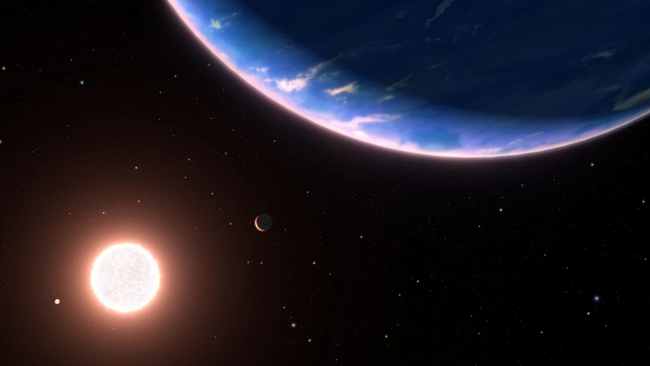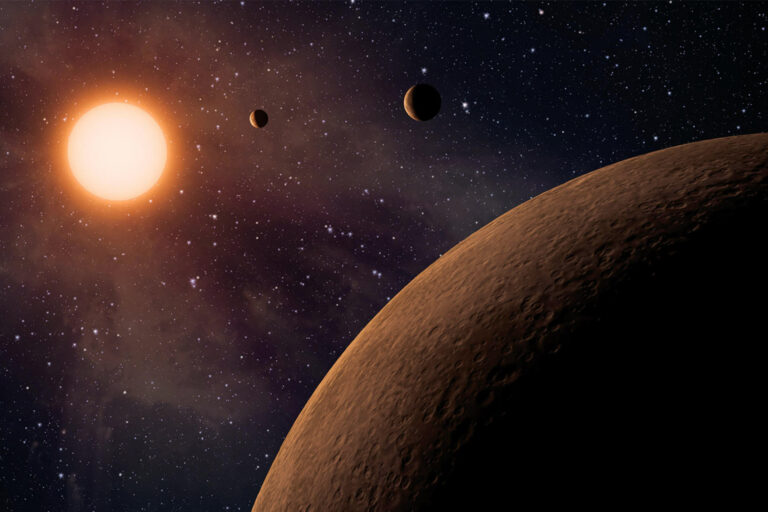Hubble Makes ‘Exciting Discovery’ of Water Encircling Small, Sizzling Exoplanet
The discovery of water on a planet of this size is a significant milestone. It brings us closer than ever to understanding and classifying planets that closely resemble Earth.

Using the Hubble Space Telescope, astronomers have made a significant finding regarding a planet outside our solar system. They have discovered that the atmosphere of this relatively small planet is abundant in water vapor. However, before you start planning a trip to this destination, it is important to note that the planet’s surface is extremely hot, reaching temperatures that can melt lead. Consequently, it is an inhospitable world unsuitable for life as we know it.
Specifically, the team responsible for this discovery has identified an exoplanet called GJ 9872d, which exhibits temperatures similar to those found on Venus, reaching 752 degrees Fahrenheit (400 degrees Celsius). Despite the harsh conditions, this finding remains highly exciting.
While scientists have previously detected water vapor in the atmospheres of other exoplanets, the observations made by the Hubble Telescope on this hot and steamy world, known as GJ 9827d, mark a significant milestone. It is the smallest exoplanet to date where an atmosphere containing this essential element for life has been detected.
Laura Kreidberg, a team member and director of the Max Planck Institute for Astronomy’s Atmospheric Physics of Exoplanets department, expressed her enthusiasm about the discovery of water on GJ 9827d. She highlighted that it is particularly exciting because it is the smallest planet where an atmosphere has been detected, bringing us closer than ever to characterizing truly Earth-like worlds.
GJ 9827d, which is approximately twice the width of Earth, orbits a star named GJ 987 situated about 97 light-years away from us in the direction of the Pisces constellation. This star is estimated to be around 6 billion years old and hosts three Earth-like planets, with GJ 9827d being one of them. Björn Benneke, a scientist at the Trottier Institute for Research on Exoplanets at Université de Montréal, expressed that the detection of water-rich atmospheres on these planets around other stars would be a groundbreaking achievement. This discovery is a significant step towards understanding the prevalence and variety of atmospheres on rocky planets.
Nonetheless, a crucial question remains unanswered: What kind of planet is GJ 9872d?
“The nature of these relatively small planets, ranging from two to three times the size of Earth, is still uncertain,” Kreidberg stated. “They could be genuine super-Earths, consisting of a substantial rocky core with a light atmosphere, or they could be entirely distinct, such as a water world primarily composed of water ice, which has no equivalent in our own solar system.”
Water world or hydrogen-rich mini-Neptune?
During a three-year observation, Hubble witnessed GJ 9827d transit its star a total of 11 times. This phenomenon allowed scientists to analyze the planet’s atmosphere by studying the characteristic wavelengths of light absorbed by different chemical elements and compounds.
The astronomers involved in this study are currently uncertain about the composition of GJ 9872d’s atmosphere. Hubble’s observations suggest the presence of a small amount of water in a hydrogen-rich atmosphere, but it is unclear whether water vapor dominates the planet’s atmosphere.
Pierre-Alexis Roy, the lead author of the research and a scientist at the Trottier Institute for Research on Exoplanets at Université de Montréal, expressed excitement about both possibilities. Whether water vapor is the dominant component or just a minor species in a hydrogen-dominated atmosphere, the findings would be significant.
If GJ 9872d has remained close to its parent star throughout its 6 billion-year existence, intense radiation would have likely evaporated any primordial hydrogen, resulting in an atmosphere primarily composed of water vapor. The lack of detected hydrogen around GJ 9872d supports this hypothesis.
Alternatively, if GJ 9872d still retains a hydrogen-rich envelope with water, it would be classified as a mini-Neptune. This type of planet is less massive than Neptune but shares similarities with the ice giants in our solar system, possessing a thick atmosphere of hydrogen and helium.
Another possibility is that GJ 9827d resembles a larger and hotter version of Jupiter’s moon Europa. Scientists believe Europa contains twice as much water as Earth beneath its icy crust. In this scenario, GJ 9827d could be composed of half water and half rock, with a significant amount of water vapor enveloping a smaller rocky body.
If GJ 9827d indeed possesses a thick atmosphere of water vapor, it suggests that the planet formed farther away from its star, where temperatures were lower, before migrating to its current position.
The exoplanet GJ 9827d would have experienced an increase in radiation from its host star during its migration, causing the transformation of potential ice into liquid water and water vapor. The heat would have also affected any present hydrogen, causing it to gradually escape from the planet’s atmosphere due to its relatively low gravity. This process of hydrogen leakage may still be occurring as astronomers continue to observe the exoplanet.
According to Benneke, the direct detection of the atmosphere of such a small planet was not possible until now. However, advancements in our understanding have brought us closer to studying smaller planets and their atmospheres. Eventually, there will be a transition where these small worlds no longer contain hydrogen and their atmospheres resemble that of Venus, which is primarily composed of carbon dioxide.
The study of GJ 9827d using the Hubble Space Telescope has identified it as a promising candidate for further investigation with the James Webb Space Telescope (JWST). This ongoing work aims to provide more detailed information about the planet, particularly its atmospheric composition and the presence of other molecules such as carbon dioxide.
Kreidberg concluded that the observations of GJ 9827d with the JWST are still ongoing, and the hope is to gain more insights into its atmospheric makeup. The search for answers regarding water worlds is expected to be resolved soon with the data obtained from these observations.
The team’s research was published last year in The Astrophysical Journal Letters.
Do not forget to share your opinion with us to provide you with the best posts !




0 Comments